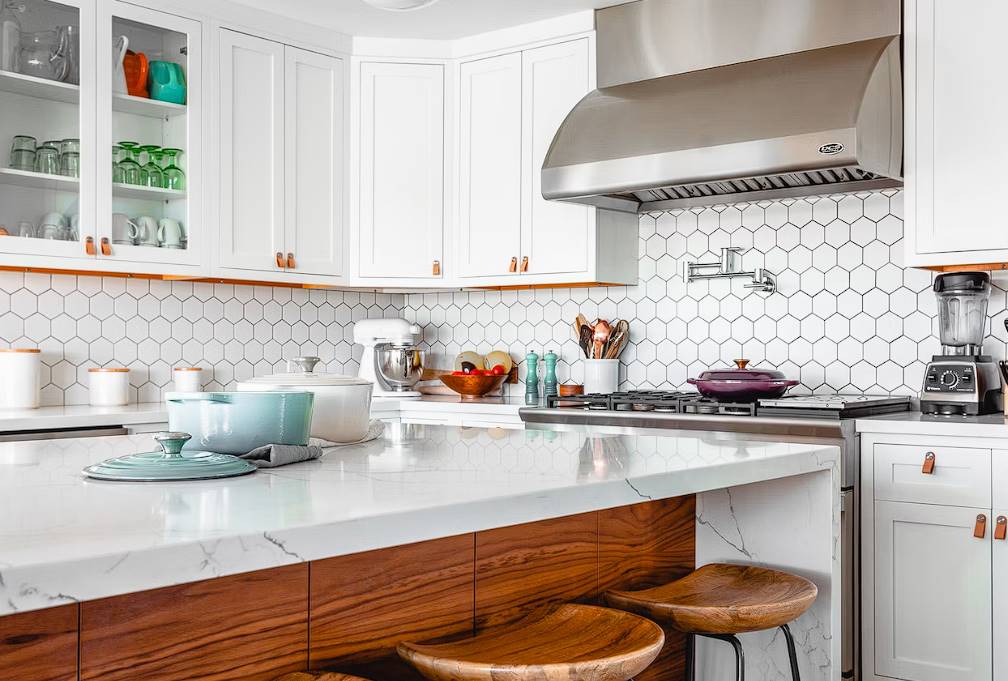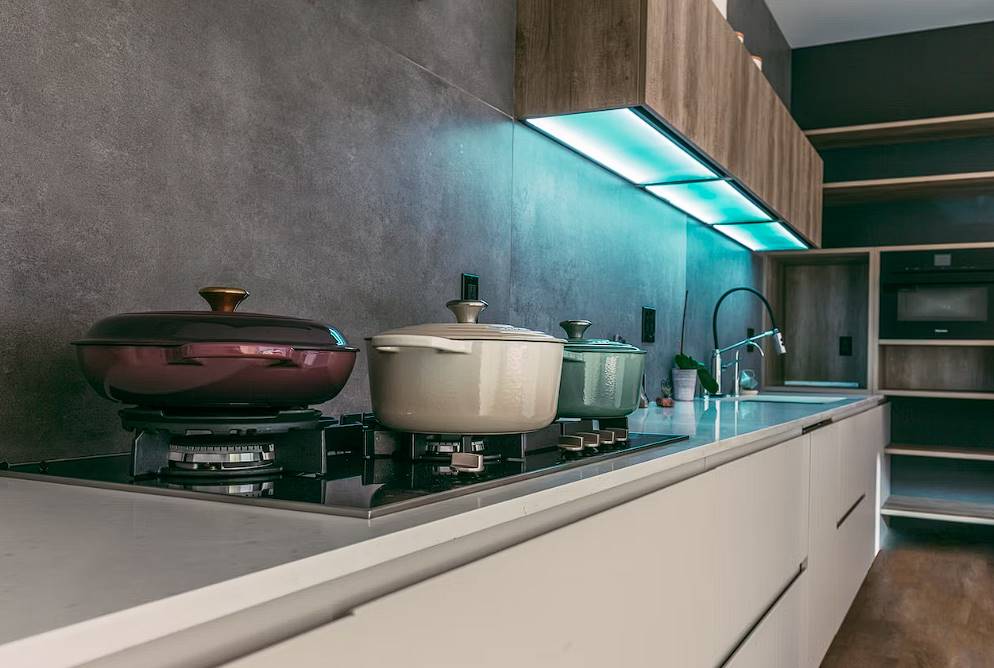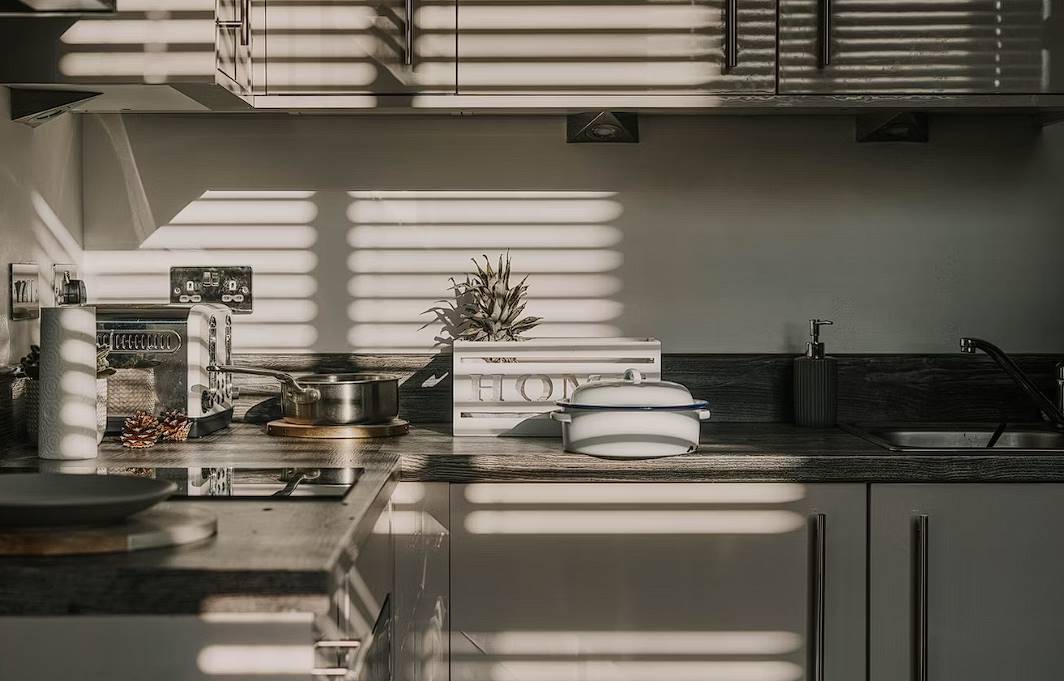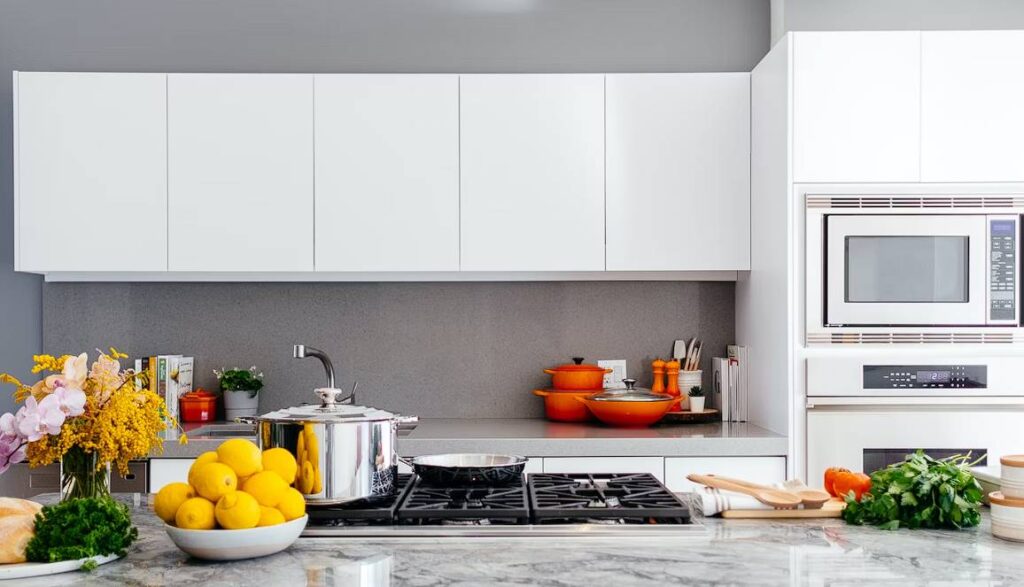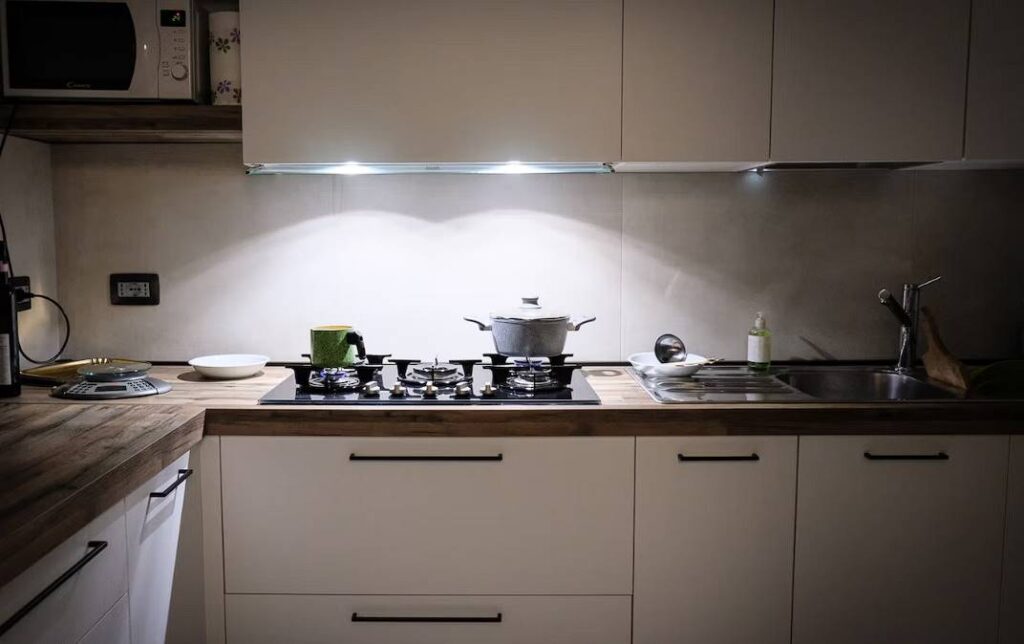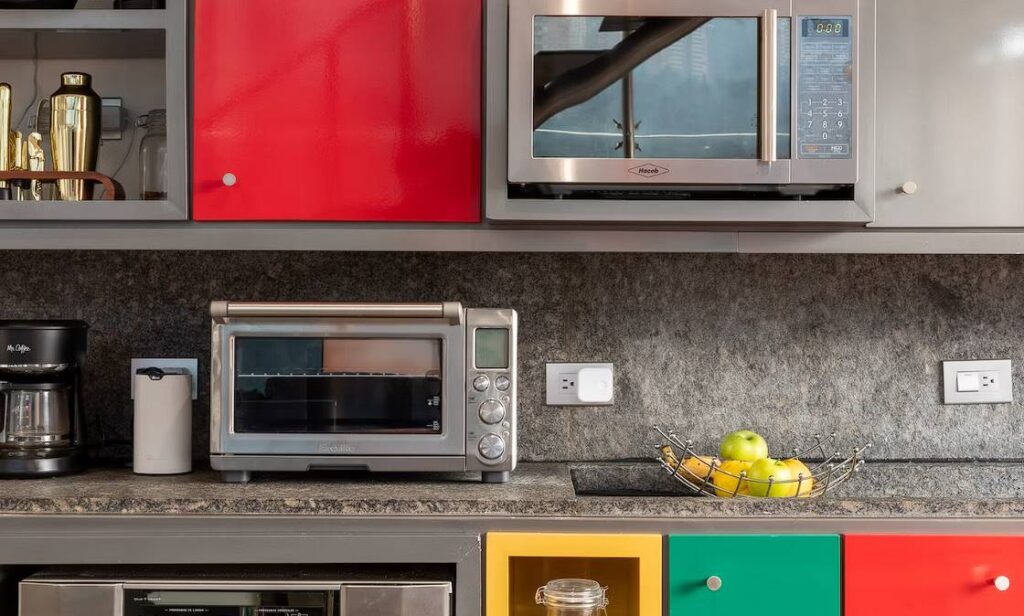DIY painting projects like painting your kitchen cabinets may be a lot of fun. However, you'll need to pick out the paint you'll be using before you can get to work. Because there is such a wide selection of paints, it can take time to determine the most effective. Chalk paint is frequently recommended as a type of paint.
Is it true that chalk paint can be used to transform kitchen cabinets? It dries rapidly but takes a while to cure fully. You can start painting immediately without first priming the surface, but topcoats will be required to prevent chipping. Adding a wax topcoat is optional but makes the finish more long-lasting. Of course, what you get out of your kitchen depends on your expectations, budget, and the amount of work you're willing to put in.
What Exactly Is Chalk Paint?
Chalk paint's distinctive characteristics and simple application have led to its popularity. Calcium pigments, carbonate, and a binder make up this water-based paint. The matte, chalky finish that chalk paint provides is the inspiration for the name.
Compared to traditional paints, chalk paint rarely requires any priming or sanding prior to application. Therefore, time-consuming procedures like sanding and priming are unnecessary. Instead, most surfaces need a quick clean and degrease before being painted.
The kitchen cabinets are just one surface that can benefit from the adaptability of chalk paint. It's available in a wide range of hues and coatings, so you can give your cabinets a look that's uniquely you. In addition, chalk paint can be used to create various looks, from smooth and modern to distressed and antique.
What Are The Advantages Of Chalk Paint
Instead of using a paintbrush, roller, or spray paint, you may have fun with chalk paint. While some people are content to stick with tried-and-true methods, others are eager to try something new, such as painting their kitchen cabinets with chalk paint. In addition, some people recommend chalk paint because it dries quickly, needs little priming, is water-based, holds up well after waxing, and can be sanded to a smooth finish.
One of the many benefits of using chalk paint is how quickly it dries. The drying times for various paints can vary greatly. Expert designers claim that an hour is all it takes for chalk paint to dry and that a second coat can be applied two to four hours later.
There Is Very Little Prep Work Required.
You can skip the primer step when using chalk paint, which is one way it differs from regular paint. You can now remove the paint and brush and recreate your dream kitchen cabinets. Even if you plan to use latex paint, another popular option, you'll still need to prepare the surface for painting by cleaning it thoroughly and applying a primer.
Although chalk paint may be applied directly to most surfaces, the smoother the surface, the better it will hold the paint. To avoid any traces of dirt or dust being pushed under the new paint, Use a damp cloth to clean the surfaces of your cabinets before painting. A better appearance will result from this. Skipping this step will give the final product a rougher texture, but it can be used for decoration if desired.
Varieties Of Finishes And Versatility
You may give your kitchen cabinets a unique look using chalk paint's many different sheens. For example, chalk paint can create a smooth, modern look or a weathered, vintage feel, depending on your aesthetic preferences. Layering, distressing, and decorative waxes are just a few of the techniques you can try to create one-of-a-kind finishes that reflect your individual taste.
Water-Based
Water-based paints are more versatile than their oil-based counterparts because of their fluid consistency. Other common kinds of water-based paint include acrylic and latex. Unlike other water-based paints, chalk paint doesn't require a primer to adhere to the surface you're applying; instead, it primes the surface as it dries.
Oil-based paint is notoriously messy and difficult to clean up after use. In addition, oil-based paint is more difficult to fix if you make a mistake than water-based paint. If you've been painting with water-based paints, you'll find that soap and warm water quickly remove the paint from your hands and brushes.
Vintage Appeal And A Distressed Look
Chalk paint is a great tool for creating a weathered look in the kitchen, whether for a shabby chic or rustic theme. After painting your cabinets, you can give them more character and charm by lightly sanding specific portions or using a sanding block. This classic style can make your kitchen feel warm and welcoming.
Sanded To Finish Smoothly
Instead of the shiny appearance that some paints can have, a kitchen painted with chalk paint will have a matte appearance. Unlike latex paint, it won't be glossy and won't reflect as much light.
This effect is not limited to your kitchen cabinets; it can be achieved on any piece of furniture painted with chalk paint. In addition, your kitchen cabinet finish can be improved by lightly sanding it before and after painting.
Durable (After Waxing)
Waxing the paint will preserve its glossy finish and give your car a classic look for years. One reason for this is that chalk paint is typically more substantial than other types of paint.
You can also use chalk paint to give your cabinets a more vintage, rugged appearance. Skipping the waxing process and letting the paint give itself a chalky appearance is a great way to achieve a gritty, rustic look for any piece of furniture, including kitchen cabinets, coffee tables, dining tables, and kitchen islands. Unfortunately, for the same reason, many consider chalk paint purely ornamental.
What Are The Disadvantages Of Chalk Paint
Using chalk paint does have a few drawbacks to consider, including the fact that it cures slowly, requires an extra protective wax top coat, is more expensive than other paints, chips easily and requires frequent touch-ups, and occasionally leaves brush marks. Paint your kitchen cabinets professionally if you don't want to deal with these issues, or choose a different type of paint.
Chips Easily And Requires Frequent Touch-Ups
Skipping the application of a wax sealant increases the likelihood that the chalk paint will chip over time. So even if you think the paint is dry, it must still be fully adhered to the surface you're working on.
The paint will need to be reapplied after a few months because it chips easily. Whether or not you're willing to touch up your kitchen cabinets throughout the year is something to consider. This may be fine if you wear a weathered, chalky look with your furnishings. Milk paint is another option to consider if you're going for a weathered, chippy look.
Colour Options Are Limited
More flexibility in choosing colours is easily chalk paint's biggest drawback. While a wide range of colours is available for chalk paint, most people use it in its neutral off-white to darker grey and brown tones. This restriction can make personalisation more challenging when trying to create a feeling of unity in a larger space or room.
Some people also don't like chalk paint because of its typically matte finish. Especially when using lighter colours, the paint often takes on an uneven texture and requires additional coats to achieve full coverage in some areas. Many people will apply a polyurethane or varnish to the surface to protect against dirt and grime and make cleaning easier.
Cures Slowly
If you're considering using chalk paint, you should know it dries quickly but cures slowly. Curing occurs when the paint's chemicals strongly bond with the surface's materials. It is only sometimes the case that dry paint is fully cured. Even after the paint has dried, it can be scratched off with a fingernail.
It usually takes chalk paint about 24 hours to cure completely. It's important to remember that this could make your kitchen painting and redesign project take longer than expected.
Possibility Of Brush Marks
Chalk paint requires multiple coats for optimal results. You can leave brush strokes in the final product if you must be more careful.
If that differs from an element you want to see in the final product's design, you may need to make alterations. One thing you can do to update your wood kitchen cabinets is to start painting in the same direction as the grain. That way, your kitchen cabinet paint will dry to a uniform, smooth coating.
Altering the paint you use is yet another alternative. To minimise the appearance of brush strokes, use paint with a longer drying time, such as an oil-based variety. Use specialised brushes, like a rounded brush, to paint with chalk and maintain clean brush strokes.
You can also buy a spray gun to avoid the need for brushes and stroking altogether.
Not Recommended For High-Moisture Areas.
Using chalk paint in wet areas, like around the sink or dishwasher, is not a good idea. Chalk paint is more easily damaged by water because of its porous nature. It is suggested that paint with higher moisture resistance be used in these areas.
Achieving A Smooth Finish Can Be Difficult
It can be difficult to get a flawless finish when starting with chalk paint. Chalk paint's texture makes it more difficult to avoid brush or roller marks, so the expert technique is essential for a professional finish. To get the desired coverage and smoothness, it may take several coats.
A Protective Wax Top Coat Is Required.
Although a primer isn't required for chalk paint, a wax top coat may be. Keeping it as a long-lasting paint for cabinets requires this extra layer of wax. Because wax is thicker than typical paint, you may need to invest in specialised brushes to work with it. Brushes specifically designed for painting with wax have softer bristles that allow the painter to distribute the wax over the painted surface.
Before Using Chalk Paint: Things To Keep In Mind
Your kitchen cabinet material, available funds, and the amount of time you can commit to painting cabinets are all factors to consider. You can hire professional painters to do the job if the effort required is too great compared to the potential benefits.
Maintenance
You should know that chalk paint may need touch-ups in the future. Matte surfaces often show fingerprints, smudges, and other traces of fingerprints. Maintaining the quality of your cabinetry may require regular cleaning and occasional touch-ups. Your willingness to put in the time and effort required to maintain the painted surfaces should be a top priority.
Surface Preparation
The kitchen cabinets should be thoroughly cleaned and degreased before being painted with chalk paint, even though this type often requires less preparation. Make sure there is no dirt, grime, or other residue on the surface that could prevent the paint from sticking. The paint will stick better, and the surface will be smoother after this step.
Sealing And Protection
While chalk paint can make a nice finish, it may need extra safeguarding in high-traffic areas like the kitchen. Protecting freshly painted surfaces from scuffs, stains, and moisture is as easy as applying a topcoat or wax sealant. To ensure the longevity and durability of your cabinets, consider taking the extra step of sealing them.
Colour Selection
Since chalk paint comes in various colours, picking the right colour scheme and style for your kitchen is essential. Consider how the room is lit, the current furnishings, and your tastes. Before painting all the cabinets, it's a good idea to test the colour on a small area or a sample board.
Style And Finish
Using chalk paint, which has a matte, chalky texture, on your kitchen cabinets can give them a distinctive appearance. Think about how well this finish fits in with your overall aesthetic goals. Consider looking into other paint options or using a topcoat or wax sealant if you prefer a glossy or satin sheen.
Surface Material
You can paint just about anything with chalk paint. First, however, you should think about the kitchen cabinet material. To improve paint adhesion and durability on laminate cabinets, you may need to take extra measures like cleaning, sanding, and using a bonding primer.
Conclusion
Chalk paint is a popular choice for DIY painting projects, as it dries quickly and requires little priming. It is available in a wide range of hues and coatings, and can be used to create various looks, from smooth and modern to distressed and antique. Advantages of chalk paint include dries quickly, needs little priming, is water-based, holds up well after waxing, and can be sanded to a smooth finish. Chalk paint is a popular choice for kitchen cabinets due to its quick drying time and minimal prep work. It can be applied directly to most surfaces, but a damp cloth should be used to clean the surfaces before painting.
Varieties of finishes and versatility are available, such as smooth, modern, weathered, and vintage. Water-based paints are more versatile than oil-based paints due to their fluid consistency. Chalk paint is a great tool for creating a vintage appeal and distressed look in the kitchen. It has a matte appearance, is durable, and can be improved by lightly sanding before and after painting. However, it has a few drawbacks, including the fact that it cures slowly, requires an extra protective wax top coat, is more expensive, chips easily and requires frequent touch-ups, and occasionally leaves brush marks.
Paint your kitchen cabinets professionally if you don't want to deal with these issues, or choose a different type of paint. Chalk paint is a popular choice for kitchen cabinets, but it has limited colour options and a matte finish. It dries quickly but cures slowly, and can be scratched off with a fingernail. It requires multiple coats for optimal results, and can leave brush marks in the final product. To update wood kitchen cabinets, it is important to start painting in the same direction as the grain.
The use of chalk paint in kitchen cabinets can be difficult due to its porous nature. To achieve a smooth finish, an expert technique is needed and a protective wax top coat may be required. Before using chalk paint, it is important to consider the kitchen cabinet material, available funds, and the amount of time you can commit to painting cabinets. To ensure the longevity and durability of the painted surfaces, it may need extra safeguarding in high-traffic areas like the kitchen. To test the colour on a small area or sample board, it is a good idea to test the colour on a small area or sample board. To improve paint adhesion and durability on laminate cabinets, it may need to take extra measures like cleaning, sanding, and using a bonding primer.
Content Summary:
- DIY painting projects like painting your kitchen cabinets may be a lot of fun.
- However, you'll need to pick out the paint you'll be using before you can get to work.
- Chalk paint is frequently recommended as a type of paint.
- Is it true that chalk paint can be used to transform kitchen cabinets?
- The kitchen cabinets are just one surface that can benefit from the adaptability of chalk paint.
- One of the many benefits of using chalk paint is how quickly it dries.
- To avoid any traces of dirt or dust being pushed under the new paint, Use a damp cloth to clean the surfaces of your cabinets before painting.
- You may give your kitchen cabinets a unique look using chalk paint's many different sheens.
- Other common kinds of water-based paint include acrylic and latex.
- Unlike other water-based paints, chalk paint doesn't require a primer to adhere to the surface you're applying; instead, it primes the surface as it dries.
- If you've been painting with water-based paints, you'll find that soap and warm water quickly remove the paint from your hands and brushes.
- Instead of the shiny appearance that some paints can have, a kitchen painted with chalk paint will have a matte appearance.
- This effect is not limited to your kitchen cabinets; it can be achieved on any piece of furniture painted with chalk paint.
- In addition, your kitchen cabinet finish can be improved by lightly sanding it before and after painting.
- You can also use chalk paint to give your cabinets a more vintage, rugged appearance.
- Paint your kitchen cabinets professionally if you don't want to deal with these issues, or choose a different type of paint.
- Skipping the application of a wax sealant increases the likelihood that the chalk paint will chip over time.
- Whether or not you're willing to touch up your kitchen cabinets throughout the year is something to consider.
- If you're considering using chalk paint, you should know it dries quickly but cures slowly.
- It usually takes chalk paint about 24 hours to cure completely.
- One thing you can do to update your wood kitchen cabinets is to start painting in the same direction as the grain.
- That way, your kitchen cabinet paint will dry to a uniform, smooth coating.
- Altering the paint you use is yet another alternative.
- To minimise the appearance of brush strokes, use paint with a longer drying time, such as an oil-based variety.
- Use specialised brushes, like a rounded brush, to paint with chalk and maintain clean brush strokes.
- Using chalk paint in wet areas, like around the sink or dishwasher, is not a good idea.
- Although a primer isn't required for chalk paint, a wax top coat may be.
- Keeping it as a long-lasting paint for cabinets requires this extra layer of wax.
- You should know that chalk paint may need touch-ups in the future.
- Your willingness to put in the time and effort required to maintain the painted surfaces should be a top priority.
Frequently Asked Questions
Yes, you can use chalk paint on previously painted cabinets. However, it's important to ensure the existing paint is clean, in good condition, and properly adhered to the surface. Lightly sanding the cabinets and ensuring they are free from dirt and grease will help the new chalk paint adhere better.
Chalk paint can be used on various kitchen cabinets, including wood, metal, and laminate. However, it's important to consider the specific surface material and take appropriate steps for preparation and adhesion. For example, laminate cabinets may require additional cleaning, sanding, and a bonding primer before applying chalk paint. Testing a small area or a sample board beforehand is always recommended to ensure desired results.
Yes, it is recommended to seal chalk-painted kitchen cabinets to protect the finish and increase durability. Applying a topcoat or wax sealant can provide added protection against scratches, stains, and moisture. It also helps to enhance the longevity of the painted surface.
Yes, you can use chalk paint on laminate cabinets. However, proper surface preparation is crucial. Clean the cabinets thoroughly and lightly sand the surface to create a better bond for the paint. A bonding primer designed for laminate surfaces can also enhance adhesion and durability.
The durability of chalk paint on kitchen cabinets can vary depending on factors such as the quality of the paint, the level of use, and proper maintenance. With proper application and sealing, chalk paint can last several years on kitchen cabinets, providing a long-lasting finish. However, it's important to note that high-traffic areas may show signs of wear more quickly. Regular cleaning and occasional touch-ups help maintain the paint's appearance and extend its lifespan.

